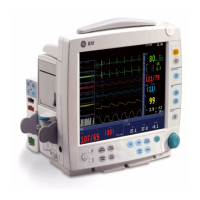B30 Patient Monitor
11-16
Selecting leads for the arrhythmia analysis
When measuring 5-lead ECG, you can affect the selection of the two ECG leads used for
detecting beats and ventricular fibrillation. The selection of user leads (ECG1, ECG2, ECG3) on
the monitor affects the leads used for detection. The first lead used for detection is lead I or II.
The algorithm uses the lead appearing first in user leads. The second lead used for detection is
one of the precordial leads (V1-V6). The algorithm uses the precordial lead appearing first in the
user leads.
To change the user lead:
1. Press the
ECG key.
2. Select a lead for ECG1 Lead, ECG2 Lead, ECG3 Lead.
The monitor starts relearning the new ECG pattern automatically.
NOTE: With the 3 leadwire trunk cable, the algorithm uses the only one available lead
ECG1 Lead, which is I, II or III, depending on the selected user lead.
Description of the arrhythmia algorithm
The bedside arrhythmia algorithm is based on template matching. A template is a group of
beats matching the same morphology. The algorithm detects QRS complexes, generates QRS
templates and performs beat labeling.
Parallel to this process there is an algorithm for detection of ventricular fibrillation. Detection of
ventricular fibrillation is based on waveform analysis.
NOTE: A physician must analyze the arrhythmia information in conjunction with other
clinical findings.
Test results of arrhythmia algorithm testing
The algorithm testing has been performed by using the following databases:
− AHA (The American Heart Association Database for Evaluation of Ventricular Arrhythmia
Detectors)
− MIT-BIH (The Massachusetts Institute of Technology- Beth Israel Hospital Arrhythmia
Database)
− NST (The Noise Stress Test Database)
− CU (The Creighton University Sustained Ventricular Arrhythmia Database)
Gross results for beat-by-beat detection (AHA)
Test Gross
QRS Sensitivity 99.84%
QRS positive preductive
accuracy
99.88%
VEB sensitivity 95.24%
VEB positive predictive
accuracy
97.24%
VEB false positive rate 0.274%

